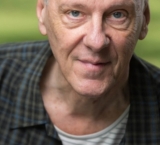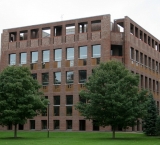Story:
Concrete Proof for Deliberate Decision Management
Permission to draw fundamental distinctions between Performance Aspiration and Health Aspiration, as described throughout Beyond Performance, McKinsey & Company, represents a landmark achievement, among statements about how to run organizations better. Prototypes supporting creative leadership in similar ways have appeared previously in other places, enriching and deepening the significance.
Dramatic older lessons concerning design innovation can now be applied more widely toward innovation for business and innovation for society.
The business of design and architecture may seem to be different from what probably comes to mind along with a standard picture of corporate business enterprise. Often a professional architectural firm will be small in size, with maybe about twenty or thirty partners and associates. But the work projects can be very large, requiring millions of dollars and many years to complete. Only a few projects are likely to be happening at any one time. This is very different from a large consumer products corporation, where there will be many thousands of employees at many locations, and many standardized units of production, with a relatively small incremental value attached to every product.
As with any creative field, intention in architecture can play a very important role. Decision and determination need to be present, to demonstrate seriousness about goals and purposes. True human commonality can be shared and celebrated at best, regardless of the immediate circumstances.
The design office of Louis Kahn in Philadelphia was active for several decades during part of the past century, roughly between 1950 and 1975.
Several directors with the well-regarded international consulting firm, McKinsey & Company, have just recently published a new approach carefully outlining a comprehensive decision process meant to be applicable toward successful organizational business transformation in many situations, anywhere in the world. The stages of the process are similar to those seen with respect to the career of Louis Kahn. The dynamics of discovery are similar. Even some of the specific diagrams associated with certain representations are surprisingly similar. The new publication is Beyond Performance. The authors are Scott Keller and Colin Price.
A deliberate and systematic decision methodology, which is displayed in stone and concrete through the course of Louis Kahn’s activities, may be a more significant contribution than the presence of the buildings physically and materially as objects of their circumstances.
In retrospect, with the benefits of hindsight, several very clear patterns emerge out of the collection of buildings produced by Louis Kahn’s architectural office over an extended period of time.
Where the architect’s concerns were consistently framed by material realities and idealized conceptual possibilities, the McKinsey scheme for organizational transformation is framed by business performance and business health, described in a well defined way.
The phases characterizing the architect’s endeavors stepped through mastery of basic practicality, technical process, social accommodation and powerful poetical expression. The phases of the McKinsey methodology cover practical business action, business process architecture, condition evaluation assessment and overall business aspiration. The sequencing of these different kinds of considerations is compatible.
There are four distinct categories. Some of Louis Kahn’s projects mostly concern careful respect for the properties and capabilities of building materials. Some projects mostly concern abstract, conceptual ideas, which in some cases may be impractical or almost unbuildable. Some projects blend together both practical and conceptual qualities, with the practical aspects being most pronounced. Some projects blend together both practical and conceptual qualities, with the conceptual qualities being most pronounced.
The emphasis, about what type of considerations would be most important, changes over time. Kahn’s early phase displays a motivation of wanting to be simple and direct with methods and materials. The next phase demonstrates wanting to be effective and honest with structural and mechanical systems. A subsequent phase emphasizes articulated accommodation of human interactions and social possibilities.
The most accomplished, later phases celebrate integration of both technical and social requirements with a high degree of economy and efficiency, as well as physical presence and beauty.
(Maybe some readers might think I am describing an Apple iPad here, and that comparison may not be completely untrue.)
The stages of awareness can be clearly tracked and delineated sequentially over time.
What is really happening here?
Early during the twentieth century, the older building styles and methods were dismissed, and a new era of scientific and technical expression became most prevalent. After the Second World War, a different set of priorities began to emerge. Here the architecture of Louis Kahn takes on a singular importance. Kahn scientifically examined and directed his own decision making process in a deliberate and systematic way. What he was trying to do was often not well understood at the time. He managed to build only about a dozen or so highly evocative singular buildings and building complexes, in many different parts of the world.
It is sometimes said that medical doctors are lucky, because they can bury their mistakes. The same remark cannot be made about architecture. Endurance becomes an unavoidable measure of meaning.
Everyone knows about famous historical buildings from the past. These are often considered to represent important expressions about cultures and civilizations, conveying a wider human purpose beyond whatever conditions may have influenced the initial construction.
Historical awareness generally, and the efforts of the office of Louis Kahn particularly, can be associated with social evolution and human progress. It is unnecessary for subsequent generations to repeat the same exercises in the same way. Hard fought discoveries yield simpler solutions, as long as attention, understanding and acceptance can come around, with the proper course of time.
It is necessary to maintain a proper perspective in confronting any accidental or apparent correlations implied in these comparisons.
The most crude and wrongheaded notion should be put aside immediately. No one should suspect that someone working with a prominent management consulting firm would have been watching what a maverick designer was doing over twenty five years ago, in order to take or to steal another person’s innovations for use in another setting.
The real importance lies in consideration of the larger political and social movements motivating the present times in which we are living. The work coming out of the architect’s office was often regarded as quirky and idiosyncratic, back then, even within the architectural profession.
Sometimes large social and cultural movements represent natural forces, just something in the air.
The more remarkable actualization may rest in the knowing that certain ways of doing things, which were previously far out along a creative and expressive edge, may be arriving more broadly in a way that may be institutionally far more beneficial for more people and for society as a whole.
In this instance, a process of cultural and social evolution appears to have left a series of noteworthy physical markers, even as the path of knowing continues to unfold.
Some of the buildings emerging late in Louis Kahn’s career have been consistently regarded as some of the finest examples of architecture produced during the twentieth century, particularly the Library for Exeter Academy in Exeter, New Hampshire, and the Kimbell Art Museum in Fort Worth Texas. The sense of place is astonishingly lyrical in its presence, and it happens that the economical dollar cost per square foot for the construction represents exceptional value in monetary terms.
As a university professor as well as an architect, Louis Khan systematically announced his exact assumptions as he initiated each project. He would carefully select his clients, in keeping with his most committed passions and interests, even as these would change over the years. In some sense, he approached each new design like a scientific experiment. He created a hypothesis. He determined precise constraints. Upon completion, he reviewed the results with stark objectivity and detachment, and he wrote about what worked out well and about what did not work out so well. Then, he readjusted his scope for the next effort. As time went on, the output of his office became increasingly more and more encompassing, in prioritizing what considerations became sympathetically well balanced together.
There are cautions with the story. An accurate understanding of Louis Kahn’s methods has been an elusive item in the academic and architectural communities, since he is still frequently dismissed as an excessively expressive creative artist, without true formal discipline. That misses the better part of what Kahn was really doing. His desire to create the most pure and authentic expression of the moment could lead to honest misconceptions and oversights. A one-to-one correlation may not be necessary, but an explanation based on certain principles from Depth Psychology can also provide a useful multi-dimensional means for navigation: Sensation, Thinking, Feeling and Intuition. The psychological concepts suggest innate polarities and progressions:
- Wanting just to be most simple and direct with materials and methods can limit integrative possibilities. Action.
- Wanting just to demonstrate effectiveness with technical processes can limit human interaction possibilities. Architecting / Planning.
- Wanting just to focus on accommodating social dynamics can result in neglect for technical necessities. Assessment.
- Wanting just to demonstrate economical integration of technical and social considerations can weaken the impact, identity and desirability of the project. Aspiration.
Ultimately, it is possible to bring many different levels of concern together with economy and integrity, but serious focus and persistence are necessary. Advance.
Investigation of the work of Louis Kahn was performed in relation to an advanced degree in design some years ago. The chairman for my own directed study committee was Dr. Stephen J. Y. Tang. Dr. Tang had spent his career as an engineer with the eminent design firm of Skidmore, Owings and Merrill, in Chicago. He was closely familiar with the structural engineering for the Sears Tower and the John Hancock Building, in addition to many other prominent projects. After he retired from practice to become a university professor, he became interested in developing his own notions of integrated decision-making, based in part on the principles he had learned as a child from his grandfather in China – including the traditional Book of Changes. The view of Kahn’s work, which emerged from the studies, was in substantial agreement with what Dr. Tang understood also to be necessary and appropriate, as emerging worldwide imperatives become more and more pressing.
Thomas Hacker, Richard Garfield -- Architects -- Office of Louis Kahn
http://download.mckinseyquarterly.com/keller_price_beyond_performance_webex.pdf
http://www.mckinsey.com/client_service/organization/latest_thinking/beyond_performance/bp_video
http://www.mckinsey.com/client_service/organization/latest_thinking/~/media/
http://designmuseum.org/design/louis-kahn
http://www.salk.edu/about/architecture.html
Image: Louis Kahn: Exeter Library 1970 Wikimedia Commons – Freely Licensed
Image: BCJ/Steve Jobs: NYC Apple Store 2010 Wikimedia Commons – Freely Licensed
Kahn's legacy has proven to present an enduring influence. A new exhibit dedicated to his works has opened this spring in Europe.
http://www.design-museum.de/en/exhibitions/detailseiten/louis-kahn-detai...
http://online.wsj.com/article/SB1000142412788732400070457838645002407872...
- Log in to post comments
Cathedrals of Culture -- Production by Wim Wenders and Robert Redford.
https://www.youtube.com/watch?v=nrdJEodg2T0
A new documentary featuring a segment on the Jonas Salk Institute in California.
Note: I met Robert Redford in person, and we shook hands, at a special screening
of his segment of the film, in La Jolla on June 28, 2014. Bragging rights here.
- Log in to post comments
Colin Price has produced an impressive short video on the Health | Performance | Five Frames Model.
https://www.youtube.com/watch?v=df645XlnX24 (Out Dated. . . .)
An earlier video on the Beyond Performance book is also available.
https://www.youtube.com/watch?v=P-EC-QikFyM (Out Dated. . . )
- Log in to post comments






You need to register in order to submit a comment.